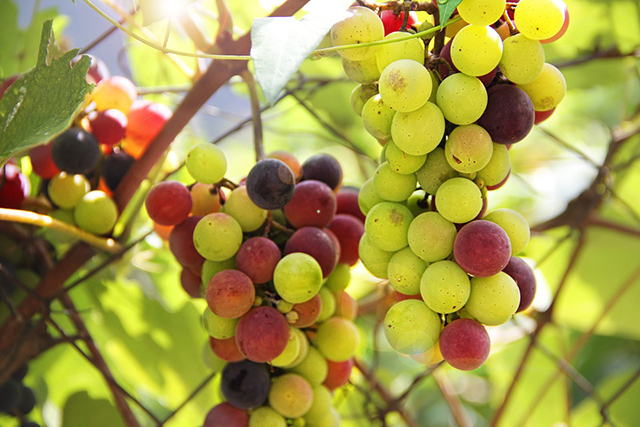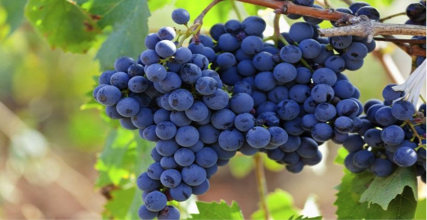葡萄品種特徵入門(二)Major Wine Grapes – Part 2
CHARDONNAY(白色)
由於赤霞珠是紅葡萄酒之王,白葡萄酒之王就是霞多麗了,因為它使持續優質,豐富和復雜的白葡萄酒。這是一款非常多用途的葡萄,可在全球各地生長良好,在勃艮第它被用於精緻的白葡萄酒,如Montrachet,Meursault,Pouilly-Fuissè和真正的夏布利。在香檳酒中,它變成了Blanc de Blancs。澳大利亞已成為霞多麗產區的主要產區,其中許多其他國家釀成霞多麗fever.
霞多麗在20世紀30年代被引入加利福尼亞,但直到20世紀70年代才開始流行,如安德森谷、卡內羅斯、蒙特雷、俄羅斯河、聖伊內斯(聖巴巴拉)和聖瑪麗亞谷等地區現在生產的葡萄酒遠遠超過20年前的葡萄酒.
雖然有一個名叫霞多麗的馬康納村莊,但是葡萄的起源並沒有明確的一致,甚至可能是中東.
製作精良時,霞多麗呈現蘋果、無花果、甜瓜、梨、桃、菠蘿、檸檬、葡萄柚、香料,蜂蜜,黃油,奶油糖果和榛子的大膽口味,成熟豐富和強烈的水果口味,釀酒師使用常見的釀造技術,例如桶式發酵,老化過程(葡萄酒留在其天然沉積物中)和蘋果乳酸發酵(一種將蘋果酸轉化為更柔軟的過程)來使這種易於操作的葡萄酒變得更加複雜乳酸),沒有其他白葡萄酒可以像橡木桶陳釀或桶裝發酵一樣享用霞多麗,霞多麗葡萄具有相當中性的風味,並且由於它們通常被粉碎或壓榨,不像紅葡萄酒那樣用果皮發酵,無論從葡萄中出現的任何風味在粉碎後幾乎立即被提取,通過發酵浸泡幾天或幾週的紅葡萄酒,可以完全不同地提取其風味.
由於霞多麗也是一個多產的生產商,每英畝可以輕鬆生產4-5噸優質葡萄,因此它是種植它的每個國家的生產者的搖錢樹,許多美國和澳大利亞的霞多麗都非常華麗美味,並且散發誘人香氣,但它們缺乏豐富性、深度、專注度,並且實際上進化得相當快,常常在一兩年內失去它們的強度和濃度,許多葡萄酒商研究並認識到這一點後,現在正在大幅度降低作物產量,將噸位降至每英畝2至3噸,相信這將導致更大的集中度,這種策略唯一的缺點是較低的作物量會導致出售葡萄酒的數量大大減少,從而導致霞多麗價格上漲.
霞多麗的受歡迎程度也導致了普通霞多麗葡萄酒的巨大市場,所以這個品種有多種質量可供選擇,有相當數量的國產霞多麗,可以從簡單和乾燥到更複雜、更高層次。生產商在葡萄酒上的名稱,通常是價格,是質量水平的唯一指標.
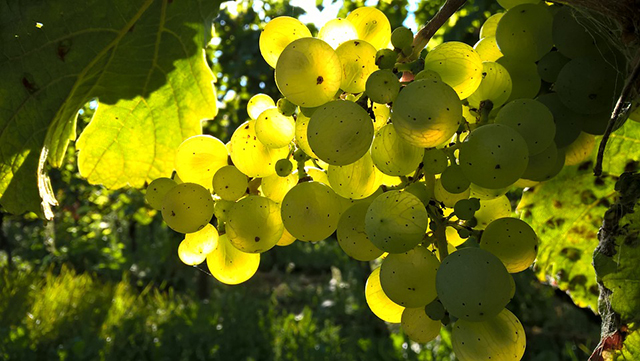
CHENIN BLANC(白)
這位盧瓦爾河谷人物有兩個性格 – 在法國,Chenin Blanc是Vouvray和Anjou,Quarts de Chaume和Saumur等著名的長壽白人的基礎,然而在其他國家,Chenin Blanc只是一個很好的混合葡萄,這是南非種植最多的葡萄,儘管它在那裡被稱為“Steen”,在南非和加利福尼亞州,它主要用作普通桌上葡萄酒的混合葡萄, Chenin Blanc在加州表現更好;它可以產生愉快的葡萄酒,帶有微妙的甜瓜,桃子,香料和柑橘香,偉大的盧瓦爾白葡萄酒從乾,新鮮到甜甜,取決於年份和製作者,在南非Chenin Blanc甚至用於強化葡萄酒和烈酒.
DOLCETTO(紅色)
除了意大利西北部皮埃蒙特以外,Dolcetto還生產柔和,圓潤,果香的葡萄酒,香氣濃郁的甘草和杏仁,應在三年內飲用,Dolcetto被用作Nebbiolo和Barbera葡萄酒生產商的安全網,需要更長的時間,有七個相關的DOC:阿奎、阿爾巴、阿斯蒂、迪諾阿爾巴、多利亞尼、朗加蒙雷加利斯、奧瓦達.
FUMÉBLANC(白色)
參見Sauvignon Blanc
GAMAY(紅色)
薄酒萊葡萄酒使其著名, 紅色果味許多來自Gamay葡萄之一,Gamay NoiràJus Blanc。酒精含量低,酸度相對較高,這些葡萄酒在裝瓶後很快就會被喝掉,博若萊新酒,幾乎在一夜之間到處都是貨架,它也生長在盧瓦爾河,但成果適中,瑞士人廣泛種植GAMAY(佳美)葡萄,主要用於與黑皮諾混合;他們經常將葡萄酒切片(即加入糖預發酵以增加葡萄酒的酒精含量).
同時加利福尼亞州種植了一種名為Gamay Beaujolais的品種,它是高產黑比諾的clones克隆品種,在大多數地方作為table wines酒。在美國,Gamay葡萄主要用於混合。然而GAMAY佳美種植面積正在下降,因為那些認真生產優質黑皮諾的品種在較涼爽的地區使用優質葡萄無性系和種植.
GEWÜRZTRAMINER(白色)
Gewürztraminer可以釀出出色的葡萄酒,法國阿爾薩斯就是最好的證明它有多種風格,從干到甜,這種葡萄需要涼爽的氣候才能熟化,它是一種生長和釀造有氣質的葡萄酒好的選擇,它的強烈辣味可以在不加選擇的情況下咄咄逼人,在最好的情況下,它產生一種清脆酸度的花香清爽葡萄酒與辛辣菜餚搭配最好,如果遲收可以產生非常豐富和復雜優質的甜品酒,它在東歐,新西蘭和太平洋西北地區也很受歡迎.
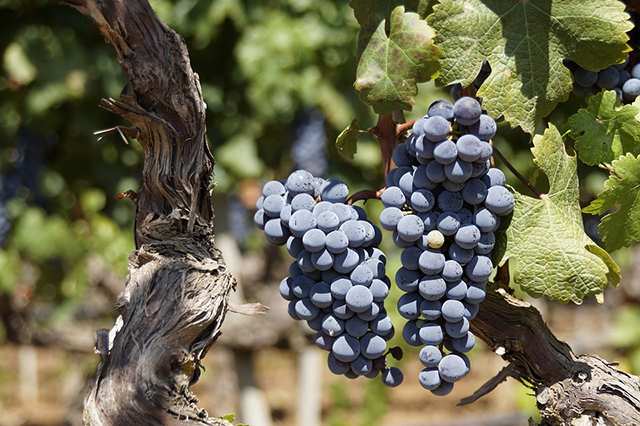
GRENACHE(紅色)
耐乾旱和耐熱,歌海娜產生果味,辛辣,中等酒體,柔順的單寧。世界上第二大種植葡萄,歌海娜在羅納河南部廣泛流行,它被混合生產Châteauneuf-du-Pape,並單獨用於Tavel和Lirac的桃紅葡萄酒;它也被用於法國的甜巴尼葡萄酒,歌海娜在西班牙很重要,它被稱為Garnacha Tinta;尤其值得注意的是里奧哈和普里奧拉托。歌海娜曾經在澳大利亞流行,但現在已被西拉超越.
一些巴羅莎谷生產商正在製作類似於新堡教皇的葡萄酒,在加利福尼亞州,歌海娜是一種混合葡萄的“主力”,雖然偶爾會找到一個古老的葡萄園,葡萄釀成的葡萄酒可能非常好,這似乎正在復甦,因為羅納風格的葡萄酒愛好者尋求涼爽的地區和適當的混合葡萄.
此外,在西班牙稱為Garnacha Blanca的Grenache Blanc瓶裝在南羅訥河谷,它被用於混合法國的Rousillon魯西榮和Languedoc朗格多克,以及西班牙各種白酒,包括Rioja.里奧哈。
GRÜNERVELTLINER(白色)
奧地利種植最廣的葡萄,在東歐其他地區的發現程度較低, 它在維也納西部多瑙河沿岸的Wachau,Kremstal和Kamptal地區實現了定性的巔峰。 由於它的簡稱,它顯示出獨特的白胡椒、煙草、小扁豆、柑橘和香味,以及高酸度,使其成為食品的優秀合作夥伴, Grüner的風味獨特,雖然它很少達到最好的奧地利雷司令的精細和繁殖,但它在酒體和質地上都很相似.
MALBEC(紅色)
波爾多和盧瓦爾在各種混合物中一度很重要,馬爾貝克一直由梅洛和兩個赤霞珠取代,然而這種不太耐寒的葡萄在阿根廷和智利取得了巨大的成功,在美國馬爾貝克僅被用作混合葡萄。然而一些釀酒廠使用馬爾貝克,因為它被認為是波爾多混合配方的一部分.
MARSANNE(白色)
Marsanne在Rhine中很受歡迎,還有Grenache Blanc,Roussanne和Viognier,在澳大利亞,尤其是維多利亞州,有一些世界上最古老的馬桑訥葡萄園,在最好的情況下,Marsanne可以是濃郁,中等強度的葡萄酒,配以香料,梨和柑橘香調.
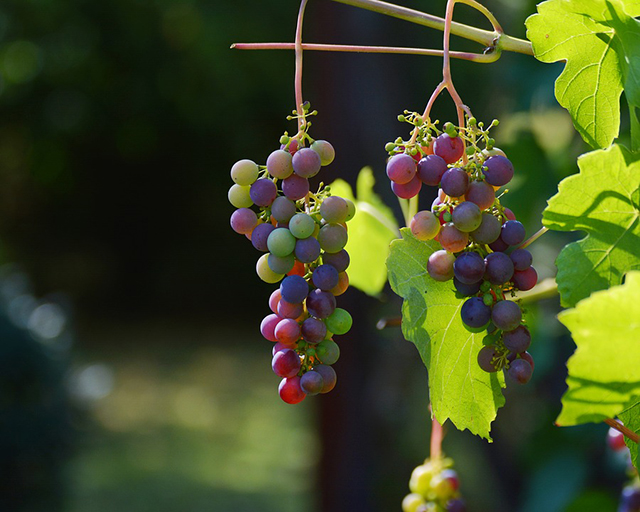
MERLOT(紅色)
美樂是21世紀最受歡迎的紅酒,它的受歡迎程度隨著它的種植面積一路飆升,似乎葡萄酒愛好者不能喝足夠多的葡萄酒,它主宰波爾多,除了梅多克和格雷夫斯,雖然它主要用於波爾多混合,但它可以獨立使用。特別是在St.-Emilion和波美侯,Merlot生產值得一提的葡萄酒,最終在ChâteauPétrus酒莊釀製,在意大利,美樂是無處不在的,雖然大部分美樂都是桌上酒,然而Ornellaia和Fattoria de Ama是特別例外,儘管梅洛受歡迎程度一直很高,但大部分時間梅洛的質量都不錯,但是在全球範圍內還是有一些忠實生產商.
幾種風格已經出現,一種是赤霞珠式梅洛,其中包括高比例的赤霞珠(高達25%),相似的醋栗和櫻桃風味以及單寧堅挺,第二種風格不太依賴赤霞珠,它更柔軟,更柔軟、中等重量、單寧較少的葡萄酒,並具有更多的草藥、櫻桃、巧克力口味,第三種風格是非常簡單和簡單的葡萄酒,這種品種推動了美樂的整體增長.
就像赤霞珠一樣,梅洛可以從一些混合中受益,因為赤霞珠可以賦予其色彩和單寧強度,它也與橡木結合, 1970年代初美樂被引入加州,隨著成熟和成熟的不均衡,這是一種困難的葡萄種植,許多葡萄酒專家認為華盛頓州的葡萄酒質量略有優勢,美樂的老化潛力是公平的,隨著年齡的增長,它會變得更柔軟,但水果味通常會消失,而草藥味則占主導地位.
Merlot Blanc是一種多元化的白葡萄.
RIESLING(白色)
雷司令葡萄的耐寒木材是世界上最好的白葡萄酒之一,因此它非常耐霜凍,該品種在較涼爽的氣候中表現優異,因為它具有緩慢成熟的趨勢,使其成為用葡萄製成的甜葡萄酒的良好來源,這種葡萄受葡萄腐爛(真菌)Botrytis灰黴病的侵害,葡萄皮會枯萎並濃縮其天然糖水平.
雷司令以生產德國Mosel-Saar-Ruwer,Pfalz,Rheinhessen和Rheingau的葡萄酒而聞名,但它在阿爾薩斯和奧地利也取得了輝煌。甜蜜的德國Beerenauslese和Trockenbeerenauslese葡萄酒以及阿爾薩斯著名的穀物貴族名莊常常因其高糖水平和幾乎無盡的陳年而聞名,但是它們非常罕見且昂貴.
更常見的是雷司令產生乾燥或乾燥的版本,它的高酸度,獨特花香、柑橘、桃子、礦物質口味,已經贏得了乾雷司令的很多粉絲,這個品種與食物配對得很好,並且具有用於傳送其葡萄園源元素(法國人稱之為terroir)的不可思議的訣竅.
來自德國摩澤爾地區的葡萄酒可能是葡萄的最純粹的表現形式,它在輕盈而活潑的框架上提供酸橙、餡餅皮、蘋果、石板、金銀花特徵,德國的Rheinhessen,Rheingau和Pfalz地區生產的葡萄酒具有相似的特點,但是增加了酒體和香料.
在阿爾薩斯,雷司令通常更具乾性風格,酒體飽滿,具有獨特的汽油香味,在奧地利雷司令在數量上僅次於Grener Veltliner,但如果種植在受歡迎的地方,則可提供非常專注和清晰的葡萄酒.
在其他地區,在加利福尼亞州、俄勒岡州、華盛頓州、紐約的手指湖區、澳大利亞、新西蘭、南非、南美和加拿大,可以找到雷司令(通常在白雷司令,萊茵雷司令或約翰斯伯格雷司令等同義詞下).
SANGIOVESE(紅)
桑嬌維塞以提供許多極好的意大利紅葡萄酒為基礎,從基安蒂和布魯內洛迪蒙塔爾奇諾到所謂的超級托斯卡納混合酒,桑嬌維塞以其柔順的口感和中等至濃郁的香料、覆盆子、櫻桃和茴香口味而聞名,當與葡萄如赤霞珠配合使用時,桑嬌維塞葡萄酒的口感更平滑,單寧酸度更低。
鑑於意大利移民在該州葡萄酒釀造遺產中發揮的強大作用,桑嬌維塞在加利福尼亞州並不受歡迎,這有些令人驚訝,然而現在葡萄似乎有一個光明的未來,無論是作為一個獨立的品種葡萄酒,並與赤霞珠、梅洛、甚至仙粉黛混合使用,隨著釀酒師更多地了解葡萄在不同地區的表現,以及葡萄品種與其他葡萄品種的融合方式,葡萄酒的風格也會隨之變化。
SAUVIGNON BLANC(白色)
白蘇維濃是另一種具有顯著香味的白色,這是一種“草地”或“麝香”,純品種主要存在於盧瓦爾,桑塞爾和普伊富姆,波爾多在許多混合葡萄酒中使用這種葡萄, Pessac-Leognan,Graves和Medoc白人也是如此;它也出現在Sauternes。新西蘭在長相思(Sauvignon Blanc)方面取得了驚人的成功,生產出自己的香味,水果風味,遍布北美,然後回到法國。
在美國,羅伯特蒙達維在70年代通過給它貼上Fum來拯救這個品種?布蘭克,並取得了巨大的成功。其成功轉型為葡萄酒的關鍵似乎在於馴服其明顯的品種強度,其極端導致刺激的草地,植物和草本風味。許多釀酒師用一種窮人的霞多麗來對待它,採用桶式發酵,老化和蘋果乳酸發酵。但它的受歡迎程度來自它是一個驚人的生產商和一個高利潤的葡萄酒。它可以清脆爽口,與食物相匹配,生產和生長的成本比霞多麗低。然而,它的銷售量較少,受到的葡萄酒人士的尊重可能低於其應有的水平。它的流行趨勢漸漸消退,有時似乎挑戰霞多麗。
Sauvignon Blanc以各種產區生長良好。 它與橡木和賽美蓉的結合良好,許多葡萄酒商為額外的身體增添了一絲霞多麗。 這種酒在年輕時飲用最好,但有時會從短期窖藏中受益。 作為一款收穫豐富的葡萄酒,它往往是太棒了,能夠釀造出複雜而口感豐富的葡萄酒。
SÉMILLON(白)
無論是單獨還是混合,這種白葡萄酒都會老化,與其傳統合作夥伴Sauvignon Blanc一起,這是Sauternes的基礎以及Graves和Pessac-Léognan的大部分乾白葡萄酒,這些混合物是豐富的甜味葡萄酒,賽美蓉是易受灰葡萄孢菌(真菌)影響的葡萄之一,澳大利亞的獵人谷使用賽美蓉獨奏來釀造一種白酒,它曾被稱為“飢餓雷司令”,夏布利或白勃艮第,在南非它曾經非常流行,被稱為“葡萄酒”,但它在那裡的重要性急劇下降。
在美國,賽美蓉作為加利福尼亞州和華盛頓的品種葡萄酒享有微薄的成功,但它在加利福尼亞的種植面積繼續減少。它可以製作出美妙的晚收葡萄酒,釀成均衡的葡萄酒,還有復雜的無花果、梨、煙草和蜂蜜味。當Semiilon與Sauvignon Blanc混合時,它增加了酒體、味道和質感,當Sémillon加入長相思時,後者得到草本植物香草,它也可以與霞多麗混合使用,更多的是填充葡萄酒的量,而不是添加任何葡萄酒的口味。
SYRAH或SHIRAZ(紅色)
法國的Hermitage和Côte-Rôtie,澳大利亞的Penfolds Grange是Syrah的主要消息來源,西拉的縮影是一種可以長達半個世紀的雄偉紅酒。葡萄似乎在許多地方生長良好,能夠呈現豐富,複雜和獨特的葡萄酒,帶有明顯的胡椒、香料、黑櫻桃、焦油、皮革和烤堅果風味,柔滑順滑的單寧,在法國南部,它可以找到各種混合方式,如在教皇新堡和朗格多克 – 魯西永,在澳大利亞被稱為西拉,西拉長期在麵包和黃油混合物中使用,但越來越多的高品質裝瓶,特別是從巴羅莎山谷的老葡萄園。
在美國西拉品質的提升令人印象深刻,它似乎有黑皮諾和仙粉黛的早期飲用吸引力,以及梅洛的幾種偏心,除Cabernet Sauvignon之外,它可能證明比其他任何紅葡萄酒更容易生長和釀造。
TEMPRANILLO(紅色)
西班牙對紅葡萄酒的主要貢獻是Tempranillo,該國是土生土長的國家,很少在其他地方種植,這是來自西班牙最重要的兩個葡萄酒產區里奧哈和里貝拉德爾杜羅紅葡萄酒的主導葡萄。
在里奧哈、普蘭尼洛經常與Garnacha、Mazuelo和其他一些小葡萄混合,當以傳統風格製作時,Tempranillo可以是石榴石色調,有茶、紅糖、香草味道,以更現代的風格製作時,它可以展現出李子、煙草、黑醋栗的香氣和口感,還有非常深的顏色和大量的單寧,無論風格如何,Riojas傾向於中等酒體,比單寧酸度更高。
在里貝拉德爾杜羅,葡萄酒也按傳統和現代風格劃分,並與里奧哈相似,然而更現代的風格的里貝拉可以是相當強大的,提供類似於赤霞珠的密度和單寧結構, Tempranillo在西班牙各地被稱為Cencibel、Tinto del Pais、Tinto Fino、Ull de Llebre和Ojo,它也在葡萄牙的杜羅河沿岸,在名叫Tinta Roriz(用於製造港口)和Tinta Aragonez之下。
TREBBIANO或UGNI BLANC(白色)
Trebbiano被譽為意大利的Trebbiano和法國的Ugni Blanc,產量極高,酒精含量低,酸度高。,它幾乎可以在任何基本的意大利白葡萄酒中找到。,它在意大利葡萄酒釀造中如此根深蒂固,它實際上是用於(紅色)Chianti和Vino Nobile di Montepulciano的混合物的製成品,但是目前大多數托斯卡尼生產商不會將其添加到他們的葡萄酒中。
法國人也經常稱這種葡萄為St.-Émilion,用於乾邑和阿馬尼亞克白蘭地。
VIOGNIER(白色)
法國羅納河谷罕見的白葡萄維歐尼葡萄是最難釀的葡萄之一, 然而花香辣白葡萄酒的粉絲對法國南部和新世界的前景感到振奮, 到目前為止,在美國生產的維歐尼大多數是單維的,具有豐富的辣味,但比它們應該具有的複雜程度低。
它被用於Condrieu的稀有白葡萄酒,有時還會在北羅納河與紅葡萄酒混合使用, 法國南部也有各種各樣的裝瓶,其中大部分都很輕。
ZINFANDEL(紅色)
仙粉黛這種非常多才多藝和受歡迎的葡萄的起源並不完全清楚,儘管它被認為來自意大利南部,是Primitivo的堂兄,它是加利福尼亞州種植最廣泛的紅葡萄酒(儘管澳大利亞也在廣泛種植這種葡萄),其中大部分是釀造成白色仙粉黛,一種腮紅色,稍甜的葡萄酒,真正的仙粉黛紅葡萄酒,是典型的加州葡萄酒,它已被用於與其他葡萄混合,包括赤霞珠和小西拉,它採用紅葡萄酒風格製成,具有漿果和櫻桃風味,溫和的單寧和漂亮的橡木色調,仙粉黛被製成了一種濃郁的,超級濃郁,口感濃烈,單寧堅韌的葡萄酒,旨在延年益壽,此外仙粉黛可用於晚收的波特式葡萄酒,其特點是非常成熟的葡萄乾風味,耐嚼的(“黃油”)單寧和15%以上的酒精含量。
仙粉黛在消費者中的受歡迎程度波動,在2000年代仙粉黛再次受到歡迎,因為釀酒師重新引起興趣,專注於適合金粉黛種植的高品質葡萄園,風格主要針對主流而不是極端,強調葡萄的辛辣、辣椒、覆盆子、櫻桃、野生漿果、李子風味以及其複雜的焦油、泥土、皮革,仙粉黛也適用於混合。
金芬黛葡萄是一種充滿挑戰的葡萄,它的漿果大小在一堆中變化很大,這可能導致成熟不均勻,正因為如此,仙粉黛經常需要更長時間地掛在葡萄藤上,以盡可能提高漿果的成熟百分比,對金芬黛葡萄栽培的關注以及對老葡萄的欣賞,傾向於生產質量均勻一致的小作物,從而為葡萄酒提供更均衡的葡萄酒。

| CHARDONNAY (White) [shar-dun-NAY] |
As Cabernet Sauvignon is the king of red wines, so is Chardonnay the king of white wines, since it makes consistently excellent, rich and complex white wines. This is an amazingly versatile grape that grows well in a variety of locations globally. In Burgundy, it is used for the exquisite whites, such as Montrachet, Meursault, Pouilly-Fuiss?, and true Chablis. In Champagne, it turns into Blanc de Blancs. Australia has become a major Chardonnay-producing area, amongst the many other countries that have caught Chardonnay “fever”.
Chardonnay was introduced to California in the 1930s, but didn’t become popular until the 1970s. Areas such as Anderson Valley, Carneros, Monterey, Russian River, Santa Inez (Santa Barbara) and Santa Maria Valley are now producing wines far superior to those made just 20 years ago.
Though there is a M?connais village called Chardonnay, there is no clear agreement as to the grape’s origin—it may even be the Middle East.
When well-made, Chardonnay offers bold, ripe, rich and intense fruit flavors of apple, fig, melon, pear, peach, pineapple, lemon and grapefruit, along with spice, honey, butter, butterscotch and hazelnut flavors. Winemakers build more complexity into this easy-to-manipulate wine using common vinification techniques, i.e. barrel fermentation, sur lie aging (during which the wine is left on its natural sediment), and malolactic fermentation (a process which converts tart malic acid to softer lactic acid). No other white table wine benefits as much from oak aging or barrel fermentation as Chardonnay. Chardonnay grapes have a fairly neutral flavor, and because they are usually crushed or pressed and not fermented with their skins the way red wines are, whatever flavors emerge from the grape are extracted almost instantly after crushing. Red wines that soak with their skins for days or weeks through fermentation, extract their flavors quite differently.
Because Chardonnay is also a prolific producer, which can easily yield 4 to 5 tons of high-quality grapes per acre, it is a cash cow for producers in every country where it is grown. Many American and Australian Chardonnays are very showy, well-oaked and appealing on release, but they lack the richness, depth and concentration to age, and have in fact evolved rather quickly, often losing their intensity and concentration within a year or two. Many vintners, having studied and recognized this, are now sharply reducing crop yields, holding tonnage down to 2 to 3 tons per acre in the belief that this will lead to greater concentration. The only downside to this strategy is that lower crop loads lead to significantly less wine to sell, which results in higher prices for Chardonnay, as well.
Chardonnay’s popularity has also led to a huge market of ordinary Chardonnay-based wines, so there’s a broad range of quality to choose from in this varietal. There are a substantial number of domestic Chardonnays, which can range from simple and off-dry to more complex and sophisticated. The producer’s name on the wine, and often its price, are the sole indicators of the level of quality.
| CHENIN BLANC (White) [SHEN’N BLAHNK] |
This native of the Loire Valley has two personalities – in France, Chenin Blanc is the basis of such famous, long-lived whites as Vouvray and Anjou, Quarts de Chaume and Saumur. However, in other countries, Chenin Blanc becomes just a very good blending grape. It is South Africa’s most-planted grape, though it is called “Steen” there. Both in South Africa and in California, it is used primarily as a blending grape for generic table wines. Chenin Blanc performs better in California; it can yield a pleasant wine, with subtle melon, peach, spice and citrus notes. The great Loire whites vary from dry and fresh to sweet, depending on the vintage and the producer. In South Africa, Chenin Blanc is even used for fortified wines and spirits.
| DOLCETTO (Red) [dole-CHET-to] |
Almost exclusive to northwest Piedmont, Italy, Dolcetto results in soft, round, fruity wines, fragrant with licorice and almonds that should be drunk within three years. Dolcetto is used as a safety net for producers of Nebbioloand Barbera wines, which take much longer to age. There are seven related DOCs: Acqui, Alba, Asti, Dinao d’Alba, Dogliani, Langhe Monregalesi and Ovada.
| FUMÉ BLANC (White) [FOO-may BLAHNK] |
see Sauvignon Blanc
| GAMAY (Red) [ga-MAY] |
Beaujolais makes its famous, fruity reds exclusively from one of the many Gamay grapes available, the Gamay Noir ? Jus Blanc. Low in alcohol and relatively high in acidity, the wines are meant to be drunk soon after bottling; the ultimate example of this is Beaujolais Nouveau, moved onto shelves everywhere almost overnight. It is also grown in the Loire, but with moderate results. The Swiss grow Gamay grapes widely, primarily for blending with Pinot Noir; they often chaptalize the wines (i.e. adding sugar pre-fermentation to increase the alcohol content of the wine).
Meanwhile, California grows a variety called Gamay Beaujolais, a high-yield clone of Pinot Noir that makes table wines in most places where it’s grown. In the United States, the Gamay grape is used primarily for blending. However Gamay acreage is declining, as those serious about producing quality Pinot Noir are using superior grape clones and plantings in cooler areas.
| GEWÜRZTRAMINER (White) [geh-VERTS-trah-mee-ner] |
Gew?rztraminer can yield magnificent wines, as is best demonstrated in Alsace, France, where it is made in a range of styles, from dry to off-dry to sweet. This grape needs a cool climate in which to ripen. It’s a temperamental grape to grow and vinify, and its potent spiciness can be overbearing when unchecked. At its best, it produces a floral and refreshing wine with crisp acidity that pairs well with spicy dishes. When left for late harvest, it’s uncommonly rich and complex, and can result in a superior dessert wine.
It is also popular in Eastern Europe, New Zealand and the Pacific Northwest.
| GRENACHE (Red) [greh-NAHSH] |
Drought- and heat-resistant, Grenache yields a fruity, spicy, medium-bodied wine with supple tannins. The second most widely planted grape in the world, Grenache is widespread in the southern Rh?ne. It is blended to produce Ch?teauneuf-du-Pape, and used on its own for the ros?s of Tavel and Lirac; it is also used in France’s sweet Banyuls wine. Grenache is important in Spain, where it’s known as Garnacha Tinta; it is especially noteworthy in Rioja and Priorato. Grenache used to be popular in Australia, but has now been surpassed by Syrah. A few Barossa Valley producers are making wines similar to Ch?teauneuf-du-Pape. In California, Grenache a “workhorse” blending grape, though occasionally an old vineyard is found and its grapes are made into a varietal wine, which can be very good. It seems to be making a comeback, since enthusiasts of Rh?ne-style wines seek cooler areas and an appropriate blending grape.
Also, Grenache Blanc, known in Spain as Garnacha Blanca, is bottled in the Southern Rh?ne. It is used for blending in France’s Rousillon and Languedoc, and in various Spanish whites, including Rioja.
| GRÜNER VELTLINER (White) [GROO-ner VELT-linner] |
The most widely planted grape in Austria, it can be found to a lesser extent in some other parts of Eastern Europe. It achieves its qualitative pinnacle in the Wachau, Kremstal and Kamptal regions along the Danube River, west of Vienna. Gr?ner, as it’s called for short, shows distinct white pepper, tobacco, lentil and citrus flavors and aromas, along with high acidity, making it an excellent partner for food. Gr?ner is singularly unique in its flavor profile, and though it rarely achieves the finesse and breeding of the best Austrian Rieslings, it is similar in body and texture.
| MALBEC (Red) [MAHL-beck] |
Once important in Bordeaux and the Loire in various blends, Malbec has been steadily replaced by Merlot and the two Cabernets. However, this not-very-hardy grape has seen great success in Argentina and Chile. In the United States, Malbec is used as a blending grape only. However, a few wineries use Malbec because it is considered part of the Bordeaux-blend recipe.
| MARSANNE (White) [mahr-SANN] |
Marsanne is quite popular in the Rh?ne, along with Grenache Blanc, Roussanne and Viognier. In Australia, especially in Victoria, there are some of the world’s oldest Marsanne vineyards. At its best, Marsanne can be a full-bodied, moderately intense wine with spice, pear and citrus notes.
| MERLOT (Red) [mur-LO] |
Merlot is the red-wine success of the 21st Century. its popularity has soared along with its acreage, and it seems wine lovers can’t drink enough of it. It dominates Bordeaux, except for the M?doc and Graves. Though it is mainly used for the Bordeaux blend, it can stand alone. Especially in St.-Emilion and Pomerol, Merlot produces noteworthy wines, culminating in Ch?teau P?trus. In Italy, Merlot is pervasive, though most of the Merlot is table wine. However, Ornellaia and Fattoria de Ama are strong exceptions to that. Despite its popularity, Merlot’s quality ranges from good to very good most of the time, though there are a few stellar producers found globally.
Several styles have emerged. One is a Cabernet-style Merlot, which includes a high percentage of Cabernet (up to 25%), similar currant and cherry flavors and firm tannins. A second style is less reliant on Cabernet; it is softer, more supple, medium-weight, less tannic wine, and features more herb, cherry and chocolate flavors. A third style is a very light and simple wine; this varietal is fueling Merlot’s overall growth.
Like Cabernet, Merlot can benefit from some blending, as Cabernet can give it backbone, color and tannic strength. It also marries well with oak. Merlot was introduced to California in the early 1970s. It is a difficult grape to grow, as it matures and ripens unevenly. Many wine experts believe Washington State has a slight quality edge with this wine. Merlot’s aging potential is fair to good. It may become softer with age, but often the fruit flavors fade and the herbal flavors dominate. Merlot Blanc is an unrelated white grape.
| MOURVÈDRE (Red) [more-VAY-druh] |
As long as the weather is warm, Mourv?dre can adopt to a wide variety of soils. It is popular across the south of France, especially in Provence and the C?tes-du-Rh?ne, and is often used in Ch?teauneuf-du-Pape; Languedoc makes it as a varietal. Mourvedre is used widely in Spain, including Valencia. In the United States, it is sought a few wineries which specialize in Rh?ne-style wines. The wine can be pleasing, with medium-weight, spicy cherry and berry flavors and moderate tannins, and it ages well.
| MUSCAT (White) [MUSS-kat] |
Known as Muscat, Muscat Blanc and Muscat Canelli, it is marked by strong spice and floral notes. Muscat can be used in blending, its primary function in California, for Moscato in Italy, and Moscatel in Iberia. This grape can turn into a wide range of white wines, from the low-alcohol, sweet and frothy Asti Spumante and Muscat de Canelli, to bone-dry wines like Muscat d’Alsace. It also can produce fortified wines, such as Beaumes de Venise, Port, Sherry, and Madiera.
| NEBBIOLO (Red) [NEH-bee-oh-low] |
Nebbiolo is the great grape of Northern Italy, and excels there in Barolo and Barbaresco, strong, ageable wines. However, it cultivation has been comparatively unsuccessful elsewhere, except for some cultivation in California. These wines are light and uncomplicated, bearing little resemblance to their Italian cousins.
| PETITE SIRAH (Red) [peh-TEET sih-RAH] |
Known for its dark hue and firm tannins, Petite Sirah has often been used as a blending wine to provide color and structure, particularly in Zinfandel. On its own, Petite Sirah can also make intense, peppery, age-worthy wines, but few experts consider it as complex as Syrah itself.
There has been much confusion about Petite Sirah’s origins. For a long time, the grape was thought to be completely unrelated to Syrah, despite its name. Petite Sirah was believed to actually be Durif, a minor red grape variety first grown in southern France in the late 1800s. However, recent DNA research shows Petite Sirah and Syrah are related after all. A study done at the University of California at Davis determined not only that 90% of the Petite Sirah found in California is indeed Durif, but also that Durif is a cross between Peloursin and Syrah.
Just to make things more confusing, in France, growers refer to different variants of Syrah as Petite and Grosse, which has more to do with the yield of the vines.
| PINOT BLANC (White) [PEE-no BLAHNK] |
Often referred to as a poor man’s Chardonnay because of its similar flavor and texture profile, Pinot Blanc is used in Champagne, Burgundy, and Alsace in France; Germany, Italy and California. Pinot Blanc can make terrific wines. When well-made, it is intense, concentrated and complex, with ripe pear, spice, citrus and honey notes. Pinot Blanc can be aged, but is best consumed early, while its fruit shines through.
| PINOT GRIS or PINOT GRIGIO (White) [PEE-no GREE or GREE-zho] |
Known as Pinot Grigio in Italy, where it is mainly found in the northeast, producing quite a lot of good, dry white wine, and the excellent whites of Collio, Goriziano. As Pinot Gris, it was grown in Burgundy and the Loire, though it has been supplanted. However, it comes into its own in Alsace—where it’s known as Tokay. Southern Germany plants it as Rul?nder. When the grape yield is good, this varietal is soft, gently-perfumed, and has more color than most whites.
| PINOT NOIR (Red) [PEE-no NWAH] |
Pinot Noir, the great grape of Burgundy, is a touchy variety. The best examples offer the classic black cherry, spice, raspberry and currant flavors, and an aroma that can resemble wilted roses, along with earth, tar, herb and cola notes. It can also be rather ordinary, light, simple, herbal, vegetal and occasionally weedy. It can also be downright “funky”, with pungent barnyard aromas. In fact, Pinot Noir is the most fickle of all grapes to grow: It reacts strongly to environmental changes such as heat and cold spells. Once picked, Pinot Noir is notoriously fussy to work with, since its thin skins are easily bruised and broken, releasing the juices. Even after fermentation, Pinot Noir can hide its weaknesses and strengths, making it a most difficult wine to evaluate out-of-the-barrel. In the bottle, too, it is often a chameleon, showing poorly one day, brilliantly the next.
The emphasis on cooler climates coincides with more rigorous clonal selection, eliminating those clones suited for sparkling wine, which have even thinner skins. These days there is also a greater understanding and appreciation of different styles of Pinot Noir wine. There is less agreement about those styles—should they be rich, concentrated and loaded with flavor, or a wine of elegance, finesse and delicacy? Or can a classic Pinot Noir be both? Even the varietal character of Pinot Noir remains subject to debate. Pinot Noir can certainly be tannic, especially when it is fermented with its stems, a practice that many vintners around the world believe contributes to the wine’s backbone and longevity. Pinot Noir can also be long-lived, but predicting with any precision which wines or vintages will age is often the most difficult challenge in forecasting.
Pinot Noir is the classic grape of Burgundy and also of Champagne, where it is pressed immediately after picking in order to yield white juice. It is just about the only red grape grown in Alsace. In California, it has excelled in the late 1980s, early 1990s and into the 21st Century. Once producers stopped vinifying it as if it were Cabernet, planted vineyards in cooler climates and paid closer attention to tonnage, quality increased substantially. California and Oregon have a legitimate claim to producing world-class Pinot Noir.
| RIESLING (White) [REES-ling] |
One of the world’s greatest white wine grapes, the Riesling vine’s hardy wood makes it extremely resistant to frost. The variety excels in cooler climates, where its tendency to ripen slowly makes it an excellent source for sweet wines made from grapes, which are subject to the rot (fungus) Botrytis cinerea, which withers the grapes’ skin and concentrates their natural sugar levels.
Riesling is best known for producing the wines of Germany’s Mosel-Saar-Ruwer, Pfalz, Rheinhessen and Rheingau, but it also achieves brilliance in Alsace and Austria. The sweet German Beerenauslese and Trockenbeerenauslese wines, along with Alsace’s famed Selection de Grains Nobles, are often celebrated for their high sugar levels and ability to age almost endlessly. However, they are rare and expensive.
More commonly, Riesling produces dry or just off-dry versions. Its high acidity, with distinctive floral, citrus, peach and mineral accents, have won dry Riesling many fans. This variety pairs well with food, and has an uncanny knack for conveying the elements of its vineyard source (what the French call terroir).
The wines from Germany’s Mosel region are perhaps the purest expression of the grape, offering lime, pie crust, apple, slate and honeysuckle characteristics on a light-bodied and racy frame. Germany’s Rheinhessen, Rheingau and Pfalz regions produce wines with similar characteristics, but with increased body and spice.
In Alsace, Riesling is most often more of a dry style and full-bodied, with a distinct petrol aroma. In Austria, Riesling plays second fiddle to Grener Veltliner in terms of quantity, but when grown on favored sites, it offers wines with great focus and clarity.
In other regions, Riesling can be found (often under synonyms such as White Riesling, Rhine Riesling or Johannisberg Riesling) in California, Oregon, Washington, New York’s Finger Lakes region, Australia, New Zealand, South Africa, South America and Canada.
| SANGIOVESE (Red) [san-geeo-VEHS-eh] |
Sangiovese is best known for providing the backbone for many superb Italian red wines, from Chianti and Brunello di Montalcino, to the so-called super-Tuscan blends. Sangiovese is distinctive for its supple texture and medium-to-full-bodied spice, raspberry, cherry and anise flavors. When blended with a grape such as Cabernet Sauvignon, Sangiovese gives the resulting wine a smoother texture, and reduced tannins.
It is somewhat of a surprise that Sangiovese isn’t more popular in California, given the strong role Italian immigrants have played in the State’s winemaking heritage. However, now the grape appears to have a bright future, both as a stand-alone varietal wine and for use in blends with Cabernet Sauvignon, Merlot and even Zinfandel. Expect sweeping stylistic changes as winemakers learn more about how the grape performs in different locales, as well as how it tastes integrated with other grapes varieties.
| SAUVIGNON BLANC (White) [SO-vin-yon BLAHNK] |
Sauvignon Blanc is another white with a notable aroma, this one is “grassy” or “musky.” The pure varietal is found mainly in the Loire, at Sancerre and Pouilly-Fume. Bordeaux uses this grape in many blended wines; the same is true for Pessac-L?ognan, Graves and the M?doc whites; it also shows up in Sauternes. New Zealand has had striking success with Sauvignon Blanc, producing its own perfumed, fruity style which spread across North America and then back to France.
In the United States, Robert Mondavi rescued the varietal in the 1970s by labeling it Fume Blanc, and met with great success. The key to its successful transformation to wine seems to be in taming its overt varietal intensity, which at its extreme leads to pungent grassy, vegetal and herbaceous flavors. Many winemakers treat it like in a sort of poor man’s Chardonnay, employing barrel fermentation, surelie aging and malolactic fermentation. But its popularity comes as well from the fact that it is a prodigious producer and a highly profitable wine to make. It can be crisp and refreshing, matches well with foods, costs less to produce and grow than Chardonnay. However, it sells for less and receives less respect from vintners than perhaps it should. Its popularity ebbs and flows, at times appearing to challenge Chardonnay.
Sauvignon Blanc grows well in a variety of appellations. It marries well with oak and S?millon, and many vintners are adding a touch of Chardonnay for extra body. The wine drinks best in its youth, but sometimes will benefit from short-term cellaring. As a late-harvest wine, it’s often fantastic, capable of yielding amazingly complex and richly flavored wines.
| SÉMILLON (White) [SEM-ih-yon] |
On its own or in a blend, this white wine can age. With Sauvignon Blanc, its traditional partner, this is the foundation of Sauternes and most of the great dry whites found in Graves and Pessac-Leognan. These blends are rich, honeyed wines. Semillon is one of the grapes susceptible to Botrytis cinerea (fungus). Australia’s Hunter Valley uses Semillon solo to make a full-bodied white that used to be known as “Hunger Riesling”, Chablis or White Burgundy. In South Africa, it used to be so prevalent that it was just called “wine grape,” but it has declined drastically in importance there.
In the United States, Semillon enjoys modest success as a varietal wine in California and Washington, but it continues to lose ground in acreage in California. It can make a wonderful late-harvest wine, resulting in well-balanced wines, with complex fig, pear, tobacco and honey notes. When Semiilon is blended into Sauvignon Blanc, it adds body, flavor and texture; when Sauvignon Blanc is added with Semillon, the latter gains grassy herbal notes.
It can also be found blended with Chardonnay, more to fill-out the volume of wine rather than to add anything to the taste of the wines.
| SYRAH or SHIRAZ (Red) [sih-RAH or shih-RAHZ] |
Hermitage and C?te-R?tie in France, Penfolds Grange in Australia are primary Syrah sources. The epitome of Syrah is a majestic red wine that can age for up to half a century. The grape seems to grow well in a number of areas, and is capable of rendering rich, complex and distinctive wines, with pronounced pepper, spice, black cherry, tar, leather and roasted nut flavors, a smooth, supple texture and smooth tannins. In Southern France, it finds its way into various blends, such as in Ch?teauneuf-du-Pape and Languedoc-Roussillon. Known as Shiraz in Australia, Syrah was long employed in bread-and-butter blends, but an increasing number of high-quality bottlings are being made, especially from old vines in the Barossa Valley.
In the United States, Syrah’s rise in quality is most impressive. It appears to have the early-drinking appeal of Pinot Noir and Zinfandel, and few of the eccentricities of Merlot. It may well prove far easier to grow and vinify than any other red wines, except for Cabernet Sauvignon.
| TEMPRANILLO (Red) [temp-rah-NEE-yo] |
Spain’s major contribution to red wine is Tempranillo, which is indigenous to the country and rarely grown elsewhere. It is the dominant grape in the red wines from Rioja and Ribera del Duero, two of Spain’s most important wine regions.
In Rioja, Tempranillo is often blended with Garnacha, Mazuelo and a few other minor grapes. When made in the traditional style, Tempranillo can be garnet-hued, with flavors of tea, brown sugar and vanilla. When made in a more modern style, it can display aromas and flavors redolent of plums, tobacco and cassis, along with very dark color and substantial tannins. Whatever the style, Riojas tend to be a medium-bodied wine, offering more acidity than tannin.
In Ribera del Duero, wines are also divided along traditional and modern styles, and show similarities to Rioja. The more modern styled Riberas, however, can be quite powerful, offering a density and tannic structure similar to that of Cabernet Sauvignon. Tempranillo is known variously throughout Spain as Cencibel, Tinto del Pais, Tinto Fino, Ull de Llebre and Ojo. It’s also grown along the Douro River in Portugal, under the monikers Tinta Roriz (used in the making of Port) and Tinta Aragonez.
| TREBBIANO or UGNI BLANC (White) [treh-bee-AH-no or OO-nee BLAHNK] |
Known as Trebbiano in Italy and Ugni Blanc in France, Trebbiano is tremendously prolific, low in alcohol, but high in acidity. It is found in almost any basic white Italian wine. It is so ingrained in Italian winemaking that it is actually a sanctioned ingredient of the blends used for (red) Chianti and Vino Nobile di Montepulciano. However, most current Tuscan producers do not add it to their wines.
The French, who also often call this grape St.-?milion, used it for Cognac and Armagnac brandy.
| VIOGNIER (White) [vee-oh-NYAY] |
Viognier, the rare white grape of France’s Rh?ne Valley, is one of the most difficult grapes to grow. However, the fans of the floral, spicy white wine are thrilled by its prospects in the south of France and the New World. So far most of the Viognier produced in the United States is rather one-dimensional, with an abundance of spiciness, but less complexity than they should have.
It is used in Condrieu’s rare whites and sometimes blended with reds in the Northern Rh?ne. There are also a variety of bottlings available from southern France, most of them somewhat light.
| ZINFANDEL (Red) [ZIHN-fan-dell] |
The origins of this tremendously versatile and popular grape are not known exactly, although it is thought to have come from Southern Italy, as a cousin of Primitivo. It is the most widely planted red grape in California (though Australia is also cultivating this grape extensively). Much of it is vinified into white Zinfandel, a blush-colored, slightly sweet wine. Real Zinfandel, the red wine, is the quintessential California wine. It has been used for blending with other grapes, including Cabernet Sauvignon and Petite Sirah. It has been made in a claret style, with berry and cherry flavors, mild tannins and pretty oak shadings. Zinfandel has been made into a full-bodied, ultraripe, intensely flavored and firmly tannic wine, designed to age. Also, Zinfandel can be used in late-harvest, Port-style wines, which feature very ripe, raisin-y flavors, chewy (“buttery”) tannins and an alcohol content above 15%.
Zinfandel’s popularity among consumers fluctuates. In the 2000’s, Zinfandel is enjoying another groundswell of popularity, as winemakers have taken renewed interest, focusing on higher-quality vineyards in areas well suited to Zinfandel cultivation. Styles aimed more for the mainstream and less for extremes, emphasizing the grape’s zesty, spicy pepper, raspberry, cherry, wild berry and plum flavors, and its complex range of tar, earth and leather notes. Zinfandel also lends itself to blending.
Zinfandel is a challenging grape to grow. Its berry size varies significantly within a bunch, which may lead to uneven ripening. Because of that, Zinfandel often needs to hang on the vine longer, in order to maximize the percentage of berries to ripen, as possible. Closer attention to Zinfandel viticulture and an appreciation for older vines, tend to produce smaller crops of uniformly higher quality, accounting for better balanced wines.

